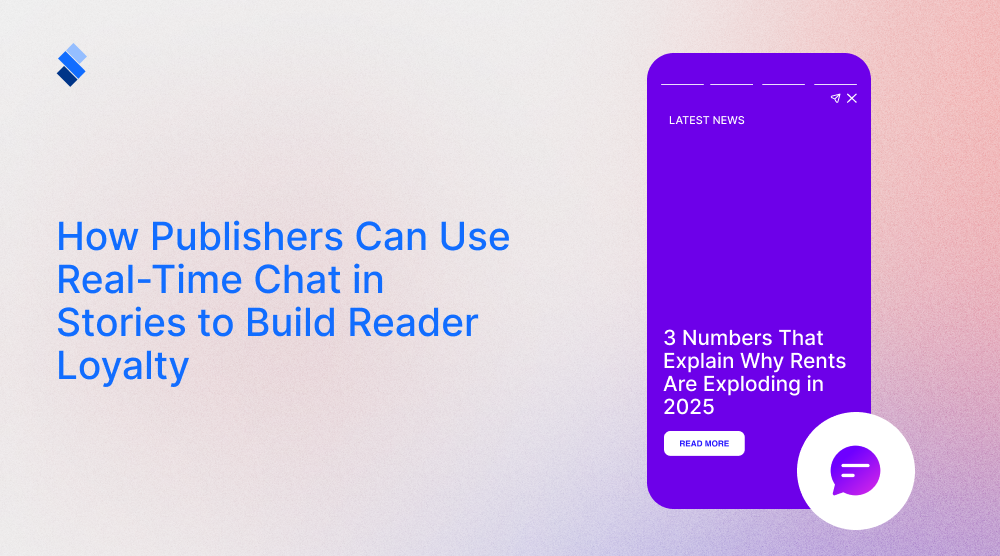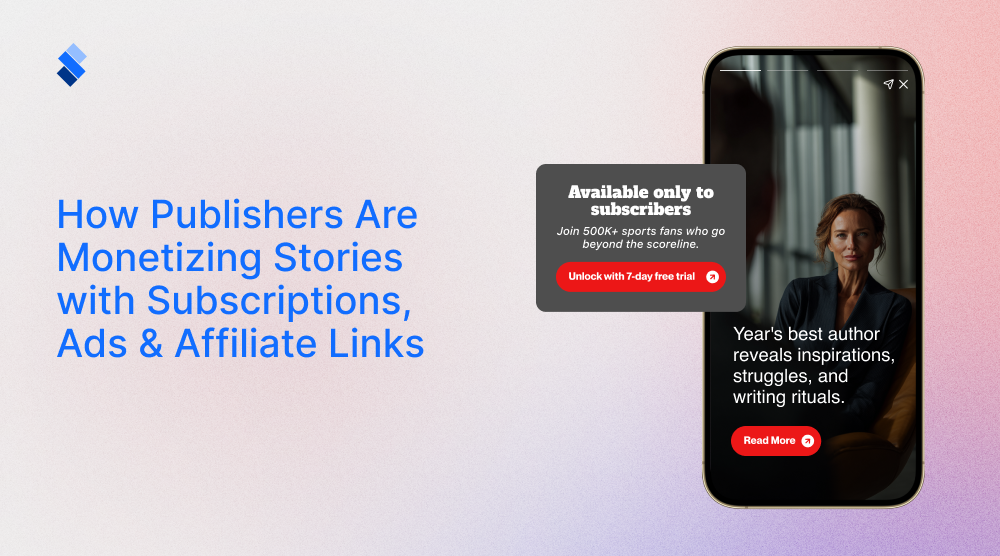CPM vs. RPM and what does it mean for publishers?
In this article, we will outline the basic metrics related to ads in publishing and help you understand the question of CPM vs. RPM.

Whether they are running a website, a magazine, or a social media page, publishers need to keep track of their metrics. Most publishers spend up to half their time tracking various KPIs to figure out whether their efforts are actually yielding results. And seeing that there are many KPIs like conversion rate or Customer Lifetime Value, it can be difficult to determine which ones to track and why. Well, in this article we will focus on Cost Per Mile and Revenue Per Mile as key metrics for ad management. So, let's take a deep dive into CPM vs. RPM and how to make use of both.
CPM vs. RPM
Let's start off by outlining the basics of CPM (Cost Per Mille) and RPM (Revenue Per Mille). These are both metrics used in the online advertising industry to measure the performance of ad campaigns. While they share some similarities, they represent different aspects of the advertising process. This is why publishers need to make use of both in order to get the full picture of ad performance. While you may be able to use AI in order to help you determine these metrics, it is still useful to have a basic understanding of what they are.
CPM (Cost Per Mille):
CPM represents the cost advertisers pay for one thousand ("Mille" Latin for a thousand) impressions of their ad. How we calculate CPM is by dividing the total cost of the ad campaign by the number of impressions (in thousands):
CPM = (Cost of Ad Campaign / Number of Impressions) x 1000
An ad impression is every iteration of your ad being shown to someone, regardless of whether they interact with it. Of course, the better your ad is, the more people will check it out. But, the mere fact that you have a big number of impressions is a good sign.

For example, let's say that a publisher pays $1000 to run an ad campaign. And let's say that during that campaign they've generated 200,000 impressions. So, the CPM would be:
CPM = ($1000 / 200,000) x 1000 = $0.005 x 1000 = $5
This means that the publisher spent $5 to get 1000 impressions for an ad.
RPM (Revenue Per Mille):
Now, of course, impressions alone won't give you a clear enough idea of how well your ads are performing. After all, a million impressions won't be worth much if they don't bring in any revenue. Well, this is where RPM kicks in. RPM represents the revenue publishers earn for one thousand impressions of ads on their website or platform. Through it, publishers can assess their overall ad revenue performance. We calculate RPM similarly to CPM. Simply divide the total revenue generated from ads by the number of impressions (in thousands).
RPM = (Total Revenue / Number of Impressions) x 1000
To give an example, let's say that a publisher earned $300 from ads and has had 10,000 impressions. Therefore, the RPM would be:
RPM = ($300 / 10,000) x 1000 = $0.03 x 1000 = $30
A quick summary
- CPM is used by publishers to measure the cost of reaching a thousand potential customers.
- RPM is used by publishers to measure the revenue earned for a thousand impressions on their platform.
Both metrics are important for different aspects of the online advertising ecosystem, as one cannot replace the other. Properly optimizing them can contribute to a more effective and profitable advertising strategy.

How to make use of them
The question of CPM vs. RPM isn't so much about whether you should use one or the other, but when. Depending on the situation, a publisher needs to make use of both CPM and RPM. So, you need to be aware of what these specific metrics are supposed to tell you.
When to use CPM
As a publisher, utilizing CPM (Cost Per Mille) as a metric offers several benefits, helping you make informed decisions and optimize your advertising strategy. Here is when you ought to use it:
Cost efficiency concerns
It is not uncommon for a publisher's primary concern to be managing costs and optimizing the efficiency of their advertising spend. After all, if you need to run multiple platforms, you really need to focus on making the most of your ad investments. Well, in this instance CPM stands as the suitable metric. By evaluating the cost of reaching a thousand impressions, you can identify which strategies are cost-effective.
Furthermore, you can look to determine a decent budget. Budget planning is especially important if you have a client that expects certain results from your marketing. Through CPM you can get insights into the cost structure and allow for better budgeting decisions. This is especially true when comparing different advertising channels or campaigns.
Brand exposure
As a publisher, you are always looking for ways to grow your audience. Ideally, you will get a quality audience that will find your content interesting and engaging. But, the common publishing practice is to first focus on quantity, then on quality. So, if your current goal is to increase brand visibility and reach a larger audience, CPM is the metric to use. Advertisers may be more interested in ensuring their ads are seen by as many people as possible, and CPM helps in assessing the cost of achieving this broad reach.
In a similar fashion, CPM is quite useful in scenarios where the main objective is to drive traffic to a website or platform, CPM can be more relevant. It provides a straightforward measure of the cost associated with generating impressions, which can be valuable for traffic-centric campaigns.
Comparing advertising platforms
In order to get a decent viewership, it is advisable to run campaigns across different advertising platforms. In theory, you can focus on one platform if you feel that your audience is niche. But, this is quite rarely the case. In the vast majority of instances, publishers make use of multiple platforms to gain as big of a reach as possible. And when they do so, they need to compare the cost efficiency of these platforms. Here, again CPM is a key metric. It allows for a direct comparison of the cost of impressions on different channels.
Performance benchmarking
Unfortunately, it is rarely enough to simply build a decent viewership and reap rewards. To get revenue, a publisher needs to build relationships with advertisers. After all, to host their ads, you need to convince advertisers that you have an interested viewership and that your viewership is only going to continue to rise. And, you may want to put more specific prices on how much it will cost to run an ad on your online space. A good benchmark to assess the cost of advertising space is CPM. Publishers may choose to present CPM data to attract advertisers looking for cost-effective opportunities to reach their target audience.

When to use RPM
Now, let's turn our view to RPM. While CPM focuses on using funds to build an audience, RPM is more about getting the most possible ad revenue from the audience you have. A slight change, but an important one. Here are some scenarios where a publisher might prefer to use RPM instead of CPM in their marketing analytics:
Focus on revenue generation
If a publisher already has a sizable audience, they will look for ways to make the most out of it. A part of this is negotiating with advertisers, but that is not the end of it. To tackle this task properly, you will need to get the full idea of how much revenue you are making. And in this case, it only makes sense to use RPM as an analytics metric. It directly reflects how much revenue is generated for every thousand impressions, providing a clearer picture of the financial performance.
By knowing the scale of your revenue, you will be able to outline different pricing models. After all, different advertisements (e.g., display ads, video ads, native ads) should cost different. Here you can use RPM to help compare the revenue generated across these diverse ad formats, giving a more holistic view.
Monetizing engagement
At a certain point, engagement becomes more important than mere impressions. After all, having thousands of people view your brand won't be worth much if they don't interact with it. Well, if you wish to tackle user engagement properly, you will need to measure the revenue generated per interaction (click, view, etc.) rather than per thousand impressions, RPM is a better fit.

Through RPM a publisher will get a better insight into how well the ads are performing in terms of generating revenue rather than just the cost of hosting them. As such, it is a key metric in brand maintenance.
Combined model
To make things perfectly clear, let's outline a basic combined model of RPM (Revenue Per Mille) and CPM (Cost Per Mille). That way, you'll have a comprehensive approach to optimizing both revenue generation and cost efficiency. This model will take into account both the revenue earned from ad impressions and the cost incurred to serve those impressions. And, with luck, will help you boost your advertising to the next level.
A key metric for this model with be one that represents the total performance of your platform. Let's call this metric the Unified Performance Index (UPI). Well calculate it thus:
UPI = (RPM - CPM) / CPM * 100
Let's remind ourselves that:
- RPM = (Revenue / Impressions) x 1000
- CPM = (Cost / Impressions) x 1000
The UPI is expressed as a percentage, and it represents the efficiency of the advertising strategy in terms of generating revenue relative to the cost of impressions. A positive UPI indicates that the revenue generated is higher than the cost, while a negative UPI suggests that the cost is higher than the revenue.
How to use UPI
In essence, there are three cases you need to consider:
- Positive UPI - You are generating more revenue than the cost, implying a profitable performance.
- Zero UPI - Your revenue and cost are in balance, with the advertising strategy covering its expenses.
- Negative UPI - Your cost of impressions is exceeding the revenue generated, signaling a potential need for adjustments in the advertising strategy to improve profitability.
Example:
Let's suppose you have an RPM of $5.00 and a CPM of $3.00.
Calculate UPI:
- UPI = ($5.00 - $3.00) / $3.00 * 100 = 66.67%
In this example, the positive UPI of 66.67% indicates that you are generating 66.67% more revenue than the cost of impressions, suggesting a profitable advertising strategy.
Of course, models that use CPM and RPM can be far more intricate. But, they all base themselves on CPM and RPM as key metrics.
Final thoughts
Now that you understand these basic metrics, it should be obvious that the question of CPM vs. RPM is only a matter of situation and need. In practice, you will likely use both to outline and then check whether your ad campaign is worth the investment. Furthermore, keep in mind that modern ad campaigns will be largely based on AI tools. So, don't shy away from further education and learn which tools and metrics will help your platform shine.







